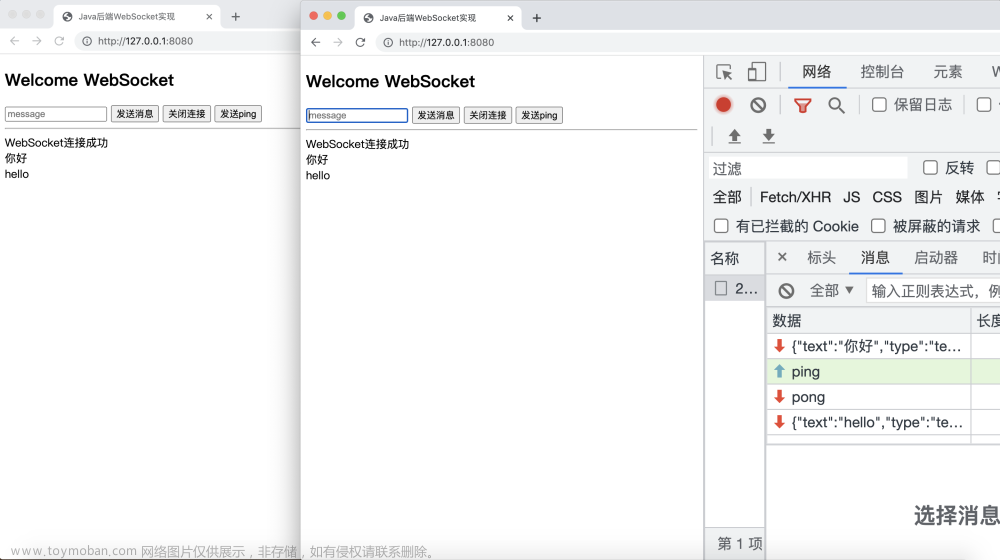工作前提:两个服务之间实现聊天通讯,因为介于两个服务,两个客户端
方案1:多个服务端,多个客户端,使用redis把用户数据ip进行存储,交互拿到redis数据进行推送
方案2: 一个服务端,多个客户端,拿到客户端的id和需要推送的id进行拼接存储
此文章使用的是方案2
1. 引入依赖包
<dependency>
<groupId>org.springframework.boot</groupId>
<artifactId>spring-boot-starter-websocket</artifactId>
</dependency>2. 加入配置进行扫描
ServerEndpointExporter 是由Spring官方提供的实现,用于扫描@ServerEndpoint注解实例。
@Configuration
public class WebSocketConfig {
@Bean
public ServerEndpointExporter serverEndpointExporter() {
return new ServerEndpointExporter();
}
}3. 服务端,这里主要是前端访问地址:ws://ip:port/push/websocket/{{"fromUserId":"321654","toUserId":"123456"}},这个地址主要用于建立连接,会去主动调用onOpen方法,然后当客户端(前端)发送消息时,会主动调用onMessage方法,再进行自己一列处理后,再推送给它需要发送的userId(用户),就去调用senndMessage方法。
@Component
@ServerEndpoint("/push/websocket/{param}")
@Slf4j
@EqualsAndHashCode
public class WebSocketServer {
/**静态变量,用来记录当前在线连接数。应该把它设计成线程安全的。*/
private static int onlineCount = 0;
/**concurrent包的线程安全Set,用来存放每个客户端对应的WebSocket对象。*/
private static ConcurrentHashMap<String,WebSocketServer> webSocketMap = new ConcurrentHashMap<>();
/**与某个客户端的连接会话,需要通过它来给客户端发送数据*/
private Session session;
/**接收userId*/
private String userId = "";
@Autowired
private InstantMessageService instantMessageService;
/**
* 连接建立成
* 功调用的方法
*/
@OnOpen
public void onOpen(Session session,@PathParam("param") String param) {
this.session = session;
if (StringUtils.isNotBlank(param)) {
JSONObject jsonObject = JSONObject.parseObject(param);
log.info("发送者数据:{},当前在线人数为{}" ,param ,getOnlineCount());
String userId = jsonObject.getString("fromUserId")+"-"+jsonObject.getString("toUserId");
this.userId=userId;
if(webSocketMap.containsKey(userId)){
webSocketMap.remove(userId);
//加入set中
webSocketMap.put(userId,this);
}else{
//加入set中
webSocketMap.put(userId,this);
//在线数加1
addOnlineCount();
}
log.info("用户连接:"+userId+",当前在线人数为:" + getOnlineCount());
sendMessage("连接成功");
}
log.info("未传输数据" + getOnlineCount());
}
/**
* 连接关闭
* 调用的方法
*/
@OnClose
public void onClose() {
if(webSocketMap.containsKey(userId)){
webSocketMap.remove(userId);
//从set中删除
subOnlineCount();
}
log.info("用户退出:"+userId+",当前在线人数为:" + getOnlineCount());
}
/**
* 收到客户端消
* 息后调用的方法
* @param message
* 客户端发送过来的消息
**/
@OnMessage
public void onMessage(String message, Session session) {
log.info("用户消息:"+this.userId+",报文:"+message);
//可以群发消息
//消息保存到数据库、redis
if(StringUtils.isNotBlank(message)){
try {
// 保存数据库中,如果报错则返回给发送者,成功推送给接收者
ResponseBean responseBean = saveMessage(message);
ErrorInfo errorInfo = responseBean.getErrorinfo();
if (errorInfo != null) {
webSocketMap.get(this.userId).sendMessage(message);
} else {
//解析发送的报文
//追加发送人(防止串改)
Map<String, Object> stringObjectMap = responseBean.getData();
if (stringObjectMap.containsKey("toUserId") && stringObjectMap.containsKey("fromUserId")) {
String userId=stringObjectMap.get("toUserId").toString()+"-"+stringObjectMap.get("fromUserId").toString();
//传送给对应toUserId用户的websocket
if (webSocketMap.containsKey(userId)) {
webSocketMap.get(userId).sendMessage(message);
} else {
//否则不在这个服务器上,发送到mysql或者redis
log.error("请求的userId:"+userId+"不在该服务器上");
}
}
}
}catch (Exception e){
e.printStackTrace();
}
}
}
/**
* 保存数据
*
* @param message
* @return
*/
private ResponseBean saveMessage(String message) {
RequestBean requestBean = JSONObject.parseObject(message,RequestBean.class);
return instantMessageService.addChat(requestBean);
}
/**
* @param session
* @param error
*/
@OnError
public void onError(Session session, Throwable error) {
log.error("用户错误:"+this.userId+",原因:"+error.getMessage());
error.printStackTrace();
}
/**
* 实现服务
* 器主动推送
*/
public void sendMessage(String message) {
try {
this.session.getBasicRemote().sendText(message);
} catch (IOException e) {
e.printStackTrace();
}
}
/**
*发送自定
*义消息
**/
public static void sendInfo(RequestBean requestBean) {
// 根据用户id和企业id标记已读 修改状态
Map<String, Object> map = requestBean.getData();
if (MapUtil.isNotEmpty(map)) {
// 处理已读
String fromUserId = map.get("fromUserId").toString();
String toUserId = map.get("toUserId").toString();
String userId = toUserId+"-"+fromUserId;
log.info("发送消息到:"+userId+",报文:"+map.toString());
if(StringUtils.isNotBlank(userId) && webSocketMap.containsKey(userId)){
webSocketMap.get(userId).sendMessage(map.toString());
}else{
log.error("用户"+userId+",不在线!");
}
}
}
/**
* 获得此时的
* 在线人数
* @return
*/
public static synchronized int getOnlineCount() {
return onlineCount;
}
/**
* 在线人
* 数加1
*/
public static synchronized void addOnlineCount() {
WebSocketServer.onlineCount++;
}
/**
* 在线人
* 数减1
*/
public static synchronized void subOnlineCount() {
WebSocketServer.onlineCount--;
}web端测试,这里传给要发送的数据回去,传输接通
@RequestMapping("socket")
public void socket(@RequestBody RequestBean requestBean) {
try {
WebSocketServer.sendInfo(requestBean);
} catch (Exception e) {
logger.error("socket处理失败", e);
}
}网上有很多写的很好的博主:这里有包含前后端文章来源:https://www.toymoban.com/news/detail-511319.html
WebSocket实现前后端通讯-java_暮冰的博客-CSDN博客_websocket前后端 文章来源地址https://www.toymoban.com/news/detail-511319.html
到了这里,关于JAVA使用WebSocket实现多客户端请求的文章就介绍完了。如果您还想了解更多内容,请在右上角搜索TOY模板网以前的文章或继续浏览下面的相关文章,希望大家以后多多支持TOY模板网!








